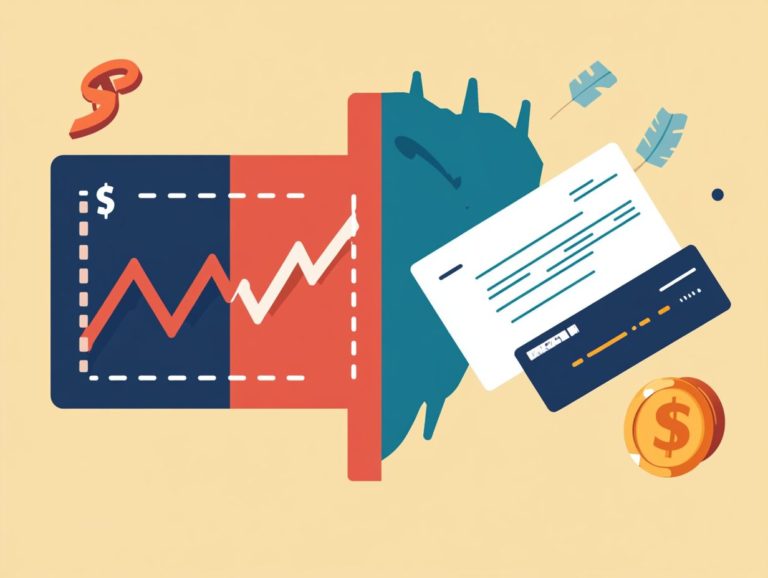Strategies for Stress Testing Your Investment Portfolio
In today s unpredictable financial landscape, grasping the resilience of your investment portfolio is more crucial than ever. Stress testing emerges as a powerful tool to simulate potential adverse market conditions, enabling you to identify vulnerabilities and make informed decisions.
This article delves into the essentials of stress testing, outlining its benefits, the key factors to consider, and the various methods you can apply. You ll also gain insights on how to interpret the results, allowing you to optimize your portfolio and ensure you re well-prepared for whatever challenges lie ahead.
Contents
Key Takeaways:

Stress testing helps identify risks and weaknesses in your investments.
Consider market volatility, economic conditions, and diversification while stress testing.
Adjusting your portfolio and rebalancing are essential steps after stress tests.
Understanding Stress Testing in Investment Portfolios
Understanding stress testing in investment portfolios is essential for financial institutions. It allows you to gauge their resilience against adverse events, regulatory demands, and market fluctuations.
This process involves evaluating how investments hold up under various simulated and historical scenarios, especially during financial crises like that of 2008.
By examining capital levels and asset adequacy, stress testing unveils valuable insights into investment risk and management strategies. This ultimately enhances the decision-making process for both managers and stakeholders.
What is Stress Testing?
Stress testing serves as a systematic process for evaluating the resilience of your investments amid hypothetical adverse financial situations. This allows for more effective risk management and informed decision-making.
Using robust methods like Monte Carlo simulation lets you explore various market scenarios. This analysis reveals the potential impact of extreme events and aids your financial planning.
You can leverage stress testing to hone your asset matching techniques, ensuring your investments align with your long-term goals while remaining flexible during turbulent times. It assists in crafting effective hedging strategies, adding a vital layer of protection against unexpected economic shifts and enhancing overall stability.
Benefits of Stress Testing Your Investment Portfolio
Stress testing offers invaluable insights into your investment risks. This analysis boosts your decision-making confidence. It also ensures your investments align with your long-term financial goals, enabling you to navigate the complexities of the market with confidence.
Identifying Potential Risks and Weaknesses

Stress testing helps you prepare for financial challenges and adapt your strategies. By simulating extreme conditions, it reveals vulnerabilities in your investments.
For example, if your portfolio is heavily weighted in technology stocks, you might face significant risks during a market sell-off. Understanding these risks enables you to explore diversification across asset classes or incorporate hedging techniques, which aim to balance returns against potential downturns.
This proactive approach helps ensure a more resilient financial outlook, no matter how unpredictable the market may be.
Improving Decision Making
Improving decision-making in your investment portfolio is one of the key benefits of stress testing. Stress testing means running different scenarios to see how your investments might perform in tough times. This allows you to make informed choices that align with your financial planning objectives.
By simulating various economic scenarios, stress testing helps you spot valuable insights into how different types of investments may react under pressure. This process also helps you identify potential vulnerabilities within your portfolio and refine your strategies to meet your overarching financial goals.
Through this data-driven approach, you can adjust allocations, enhance diversification, and manage risks more effectively. Ultimately, this ensures that your investments remain resilient even during periods of heightened market volatility.
Factors to Consider in Stress Testing
When you embark on stress testing, you need to think about various factors, such as market volatility, prevailing economic conditions, and the vital role of portfolio diversification in managing investment risk effectively.
Each element plays a significant part in ensuring that your assessments are thorough and well-informed.
Market Volatility and Economic Conditions
Market volatility and current economic conditions significantly influence the results of stress testing. They shape how your investment portfolio reacts to adverse market events.
Historical data shows how these factors connect, revealing patterns during economic downturns. It demonstrates how changing interest rates and inflation can sway investor sentiment.
By simulating various scenarios, analysts gain valuable insights into the cascading effects of these economic indicators on the risk levels tied to your investments.
As the market encounters turbulence, it s essential for you to recognize the dynamic interplay between external forces and your portfolio’s stability. This awareness enables you to adapt your strategies effectively in anticipation of potential challenges ahead.
Portfolio Diversification

Portfolio diversification is an essential strategy in your risk management toolkit. It allows you to distribute your capital across a variety of assets to reduce potential losses in challenging market scenarios.
By spreading your investments across different types of investments like stocks, bonds, real estate, and even commodities you can minimize your exposure to any single market fluctuation or economic downturn.
For example, a blend of equities and fixed-income securities can help balance the stock market’s volatility with the stability offered by bonds. Incorporating alternative assets, such as real estate or precious metals, can further enhance your portfolio’s resilience.
Effective asset allocation strategies often draw on historical correlation data to inform your decisions. This enables you to simulate potential stress testing outcomes and gain insights into how your diversified portfolio might perform in various market conditions.
Methods for Stress Testing Your Portfolio
You have various methods at your disposal for stress testing your portfolio, such as historical analysis, scenario analysis, and sensitivity analysis. Sensitivity analysis is a method that tests how different variables can impact your investment outcomes.
Each of these approaches offers unique insights into the investment risk and resilience of your holdings. This enables you to make informed decisions.
Historical Analysis
Historical analysis invites you to delve into past financial events and performance metrics. It offers insights into how investment portfolios might have performed under similar conditions.
This practice is essential, as it provides valuable context for current market dynamics. It helps you to better understand the risks associated with your assets.
For example, the 2008 financial crisis serves as a pivotal case study in stress testing scenarios. It vividly illustrates how sudden market downturns can impact liquidity and profitability.
Likewise, examining the dot-com bubble of the late 1990s reveals the dangers of overvaluation and speculative investing.
By harnessing historical data, you can uncover significant lessons about asset correlations and potential vulnerabilities. Ultimately, this enables you to make more informed decisions that anticipate volatility in today s intricate financial landscape.
Scenario Analysis
Scenario analysis uses simulated scenarios to assess how your investment portfolios might react to various stress conditions. This enhances your risk management strategies.
This method involves outlining potential future events, such as economic downturns or shifts in market dynamics. It allows you to project possible outcomes for your investments.
By scrutinizing different factors, like interest rates or geopolitical instability, you can identify vulnerabilities within your portfolio.
This analytical approach empowers you to make savvy, informed decisions. It enables you not only to guard against unfavorable conditions but also to strategically adjust your strategies in anticipation of promising market developments.
Sensitivity Analysis

Sensitivity analysis delves into how different variables impact your investment portfolios. This helps you understand the intricate relationship between various financial scenarios and portfolio risk.
By systematically adjusting key inputs such as interest rates, market volatility, and economic indicators you can uncover how sensitive an investment is to changes in these factors.
Identifying the most influential variables is crucial because it directs your focus to areas that hold the greatest potential for either loss or gain.
A solid understanding of these relationships enables you to make informed decisions. This ultimately enhances your risk management strategies and improves your overall investment outcomes.
This method clarifies the immediate effects of variable changes while nurturing a deeper comprehension of the underlying dynamics at play in the financial landscape.
Interpreting and Acting on Stress Test Results
Interpreting and acting on stress test results is essential for you as an investment manager. This process enables you to make informed adjustments to your portfolio allocation and refine your risk management strategies.
Addressing any vulnerabilities that may have been identified is key to effective management.
Adjusting Portfolio Allocation and Strategies
Adjusting your portfolio allocation and strategies based on stress test results is crucial for aligning your investments with your risk tolerance and financial goals.
By carefully analyzing the insights gained from these stress tests, you can pinpoint vulnerabilities in your current holdings. This allows you to make informed decisions strengthening your defenses against potential market disruptions or seizing new opportunities that might emerge.
This process often involves reallocating assets toward more resilient sectors or diversifying into alternative investments that can provide stability during turbulent times.
By integrating these tactical adjustments, you ensure that your investment management strategy remains cohesive and effective, ultimately supporting your long-term objectives while minimizing unnecessary risk.
Rebalancing and Risk Management
Rebalancing is essential for managing risk. It helps you adjust your investments after stress testing.
By realigning your portfolio based on market changes, you can reduce losses and take advantage of new opportunities. This keeps your investments balanced and aligned with your financial goals.
Effective rebalancing works with stress testing. Stress testing shows how different situations can affect your portfolio.
This combination helps you handle market changes more smoothly and strengthens your overall resilience.
Frequently Asked Questions
What is stress testing for an investment portfolio?
Stress testing evaluates how adverse market conditions could impact your investments.
Why should I stress test my investment portfolio?
Stress testing helps identify weaknesses in your portfolio, allowing you to adjust before risks become real. It also shows how resilient your portfolio is during tough times.
When should I stress test my investment portfolio?
It s best to stress test regularly, like every quarter or year. Also, do it during market volatility or if your investment goals change.
What are some common stress testing scenarios?
Common scenarios include economic recessions, interest rate increases, stock market crashes, and geopolitical issues. These help highlight potential weaknesses in your portfolio.
What are some strategies for stress testing?
Strategies include using past data, factoring in economic trends, and performing sensitivity analysis. You can also work with a financial advisor or use specific tools for this purpose.
What should I do after stress testing?
After stress testing, review your findings and adjust your strategy as needed. Keep monitoring your scenarios to ensure continued resilience in changing markets.
For personalized advice, consider contacting a financial advisor today!






